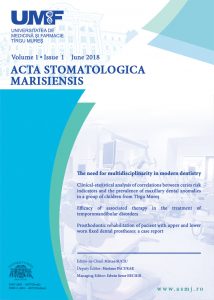Introduction: Tooth impaction is defined as the absence of a tooth on the arch, after its normal eruption age. The main reason canines are impacted is the lack of space required for the tooth to erupt.
Aim of study: The main objective of this study is to determine the types of malocclusions associated with canine impaction (Lindauer classification). A secondary objective is to establish the correlation between these parameters and identification of subjects with high risk of canine impaction based on pre-existing malocclusion.
Material and methods: This study was performed on a sample of 20 patients, 9 men and 11 women. The dental casts were subject to Angle classification and various measurements such as arch perimeter, Pont’s index, sum of the mesiodistal width of the incisor and arch length were performed. The Lindauer sectorial classification was determined based on the patients’ panoramic radiography.
Results: According to the data collected, the Class II /2 malocclusion is more frequent, and it is associated with the impacted canine (approximately 50%). According to the Lindauer classification higher frequency of the impacted canines was found in Sector IV.
Conclusion: The diagnosis for impacted canines is often associated with Class II /2 malocclusion, and according to the Sector classification, it is often localised in Sector IV.
Silvia Izabella Pop 1, Laura Roxana Contac 1, Andrei Ghiman 1, Denisa Moldovan 1, Victor Suciu 1, Janos Kantor 1, Dana Cristina Bratu 2, Smaranda Dana Buduru 3
1 George Emil Palade University of Medicine, Pharmacy, Science, and Technology of Targu Mures, Romania
2 Victor Babes University of Medicine and Pharmacy, Timisoara, Romania
3 Iuliu Hatieganu University of Medicine and Pharmacy, Cluj-Napoca, Romania
1 George Emil Palade University of Medicine, Pharmacy, Science, and Technology of Targu Mures, Romania
2 Victor Babes University of Medicine and Pharmacy, Timisoara, Romania
3 Iuliu Hatieganu University of Medicine and Pharmacy, Cluj-Napoca, Romania

Comments are closed.